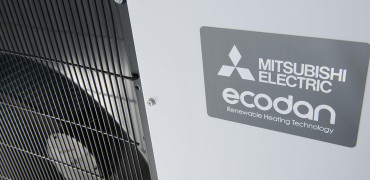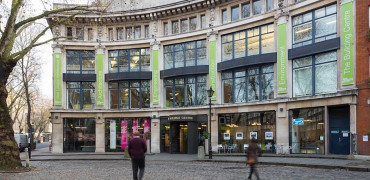I left school in 1985 and started my apprenticeship in refrigeration and I can honestly say, I’ve never looked back.
The first mobile phone call had recently been made, Ronald Regan was the US president, Eastenders premiered on the BBC, Microsoft released Windows 1.0, and there were race riots in Birmingham.
Why am I looking back in this way, you might ask?
Well, in my role as Head of Sustainability, I’m often asked to write or speak about the need to decarbonise our buildings, which of course must involve the HVAC equipment.
And I found myself thinking about the first plant room I ever visited which was in what was then the largest abattoir in Europe (a great place to learn about refrigeration, if not to everyone’s tastes!).
I have never been on a lift for so long, as it trundled down into the depths of the earth
The age of coal
To generate the heating, hot water and steam that the plant needed, we had two huge coal-fired boilers, which I was told were two of the biggest in the country at the time.
They consumed vast amounts of coal, via a screw feeding system to keep them up to temperature and generate the heat levels and pressures needed.
One of my tasks at that time was to squeeze through an inspection hatch into the water jacket of the boiler to clear out any scale and debris – I was a lot smaller then! It was definitely not a task for the feint-hearted and one that would stick with you for many years if you were claustrophobic.
As part of completing my exams, the chief engineer at the abattoir called Ron Bull (honestly, you could not make that up!), arranged with the then Coal Board for me to visit an active mine in Nottinghamshire.
It was an experience that has stuck with me ever since.
Down in the depths of the earth
We started with a safety briefing, that was far from reassuring.
This included a lesson on how to use a crude breathing device that we were told would save our lives in the event of smoke or gases filling the mine.
However, we were also told that due to the chemical reaction, it would also strip the skin from our mouths and throats but we were never to take it off no matter how painful it got!
We were taken to a locker room where we stripped naked, and issued with a vest and Y Fronts, overalls, boots, helmet light, battery pack and the respirator, before walking to the pit head to get a lift down to the mine.
I have never been on a lift for so long, as it trundled down, and down, and down, into the depths of the earth.
When it eventually did reach the bottom, we were met by a train, which we boarded, and it took us what I was told was over a mile away from the bottom of the shaft.
All the time in my head I’m thinking, if anything goes wrong, we need to make this journey back!
Literally at the coal face
When we got off the train, we went through a set of basic doors, which also act as ventilation shafts, along to where the cutting of the coal was happening.
It was a complete assault on the senses, deafeningly loud, dirty, completely dark apart from the light of your lamp on your helmet, and very, very hot.
The cutting wheel of the machine would traverse across the coal face taking what I estimated to be about a 6-to-8 inch slice of coal out of the seam, tons of it at a time – where it fell onto a conveyor, which would join with ever-larger conveyors to take the coal away and eventually to the surface.
To see this amazing sight, we had to literally climb through the machine while it was working.
The men working the machine wore a helmet, but such was the heat they had no overalls, only shorts and the sweat ran off them. Many of them were not young either.
I left that visit with a massive amount of admiration for the men working in that environment, many for their entire working lives.
I spoke to one guy who had been there thirty years by that time. Literally putting themselves on the line to provide for their families and to power the country.
A cleaner time
We are now in a very different place.
As I write this on a Friday afternoon in early April, the UK is generating only 2.6% of its electricity from the burning of fossil fuel and NONE at all from coal.
69% is being generated from wind, solar and hydroelectric.
That’s all happened in a span of almost 40 years.
What will the next 40 years look like, taking us well past 2050, when we all know we must be operating as countries, as companies and as citizens in a net zero way?
Feeding the fire
I also saw another part of this process back then.
I had two uncles that at the time worked on the large earth moving equipment you see in mines and power plants around the world.
On a couple of occasions, I was lucky enough go along with them to a site or a power plant and see these machines literally pushing thousands and thousands of tons of coal into the giant, gaping mouth of a power station (such as Ratcliffe on Soar in Nottingham), for this to be burned to generate steam and turn a generator to generate electricity.
I know there are still power stations around the world that won’t be switched off too soon, but everyone now realises that the burning of fossil fuels to generate power or heat, is now finally coming to an end and will eventually cease.
I’m not complaining! This industry has literally fired our industry for two hundred years or more, and we have all benefited from this revolution which has powered every aspect of our lives. However, we do now need to change, and quick!
An electric future
Alternative, clean, sustainable and renewable technology exists right now that can take the place of fossil fuel heating and travel using combustion engines.
Heat pumps for example can take the energy from the grid which is being produced by more and more renewable sources, and multiply this by absorbing naturally occurring (renewable) or waste heat sources for use in generating space, water and process heat.
I now drive a full electric car (BEV), light years ahead of the ‘rust bucket’ of a car I had as when I was a much younger man.
Heat and surface transport account for roughly two thirds of our emissions, so as I say, readily available, proven technologies exist today to help us make the transition.
A fair hearing
What we must do though is ensure that this transition is fair to all, and this will of course mean that prices will need to reflect both the needs of the individual and of wider society, so that we don’t leave people behind.
That’s why I get a bit cross when I read the inaccurate information circulated with alarmist wording about renewable technologies being ‘too expensive’ or ‘too complicated’, or being told that they ‘don’t work in our country, or in cold weather, or with UK types of homes’.
My colleague Russell Jones has just written a piece on The Hub bemoaning this ‘gaslighting’ by people with a vested interest in keeping things as they are and literally rubbishing our future.
For me, I sigh, but also often I find myself thinking back to that day I visited the coal mine and how far we have come in the intervening years.
I feel privileged to have actually seen all this in action and my admiration for what those coal miners did will never leave me.
However, the world has moved on and much like the tough working conditions they endured, its time for a change and time to leave the fossil fuels in the ground where they belong.
Martin Fahey is Head of Sustainability




